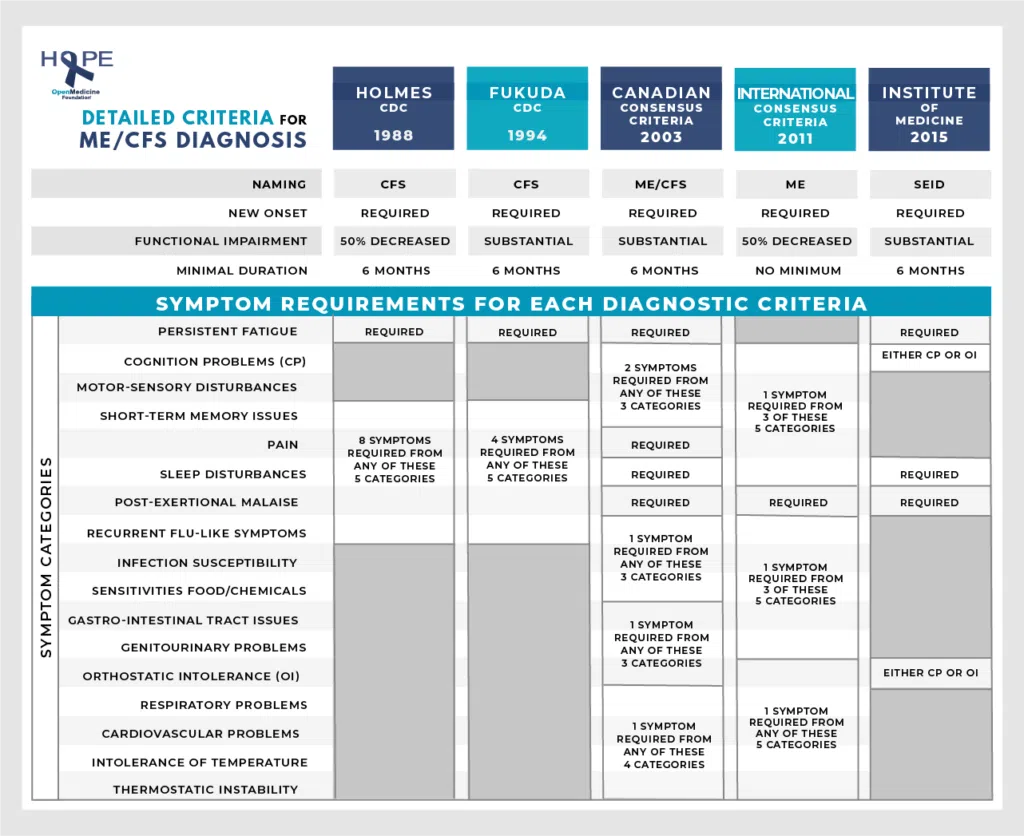
Myalgic Encephalomyelitis/Chronic Fatigue Syndrome (ME/CFS) is diagnosed after ruling out all other diseases that may explain the symptoms presented. The diagnosis relies upon a set of symptoms presented according to the type of criteria used. There are many different criteria and we have tried to simplify the most commonly used in Table 1.
Centers for Disease Control and Prevention (CDC)
Holmes 1988
This was the first definition put together by the CDC and the first to coin the term “chronic fatigue syndrome” (CFS). The definition required persistent fatigue along with 8 of 11 specific symptoms under the categories of short-term memory issues, pain, sleep disturbance, post-exertional malaise and flu-like symptoms. This diagnosis was very specific and hard to utilize in a clinical setting for diagnosis.
Centers for Disease Control and Prevention (CDC)
Fukuda 1994
This definition is a revision of the Holmes definition except it requires half the number of symptoms to make a diagnosis. This diagnosis was much easier for clinicians and significantly increased the incidence of CFS numbers globally. It has been criticized for being too easy to misdiagnose.
Canadian Consensus Criteria (CCC) 2003
From a look at Table 1 you can see a significant change in the definitions from Holmes and Fukuda to the CCC 2003. This was the first definition to incorporate CFS with the Myalgic Encephalomyelitis (ME) definition by Dr Ramsay several decades earlier. This definition requires post-exertional malaise (PEM), fatigue, pain, sleep disturbance, a couple neurocognitive issues and symptoms from the immune, endocrine and autonomic systems.
This diagnosis emphasized the multi-system component of the illness and attempted to homogenize the cohort diagnosed by requiring several specific symptoms. One of those specific symptoms, PEM, is clearly the most distinguishing feature of ME/CFS.
International Consensus Criteria (ICC) 2011
The CCC was further developed in 2011 to form the International Consensus Criteria (ICC). This was the first modern definition to not include fatigue as a required symptom and to not require 6 months of symptoms persisting to be diagnosed. PEM is the only required symptom. As compared to the CCC definition, the ICC definition puts a greater emphasis on the multi-system component of the illness, requiring more symptoms from the immune and endocrine systems.
Removing fatigue as a necessary symptom and the minimum of 6 months for diagnosis enables the differentiation of ME from CFS for considerations in research and treatment.
The improvement of research and SEID
The definition was further refined by the Institute of Medicine in 2015 to create a diagnosis that incorporated the most up-to-date research while providing a simple diagnosis in the clinical setting. The definition was a departure from all previous definitions and was therefore given a new name, Systemic Exertion Intolerance Disease (SEID). This definition is most similar to CCC in that it requires fatigue, PEM and sleep disturbance. Unlike CCC this definition only required cognitive problems or orthostatic intolerance, instead of having a broad range of symptoms to signify the multi-system component of the illness.
Simplifying the diagnosis like this is beneficial to research for building cohorts around specific symptoms that are common throughout.
Disclaimer: This website is for informational purposes only. The information provided on this website is not intended to be a substitute for professional medical advice, diagnosis, or treatment.




